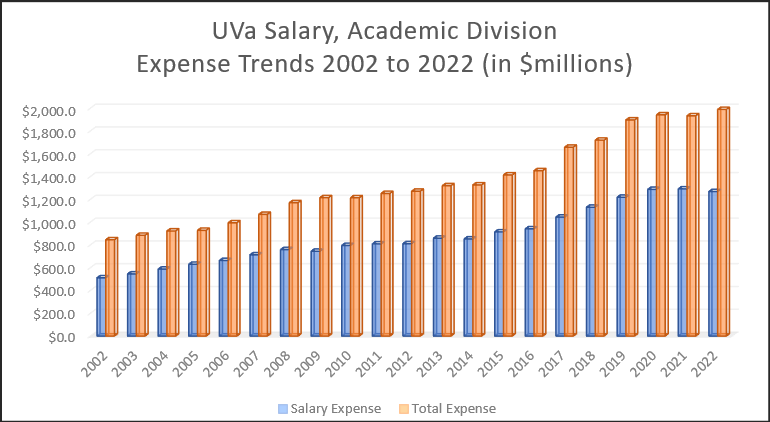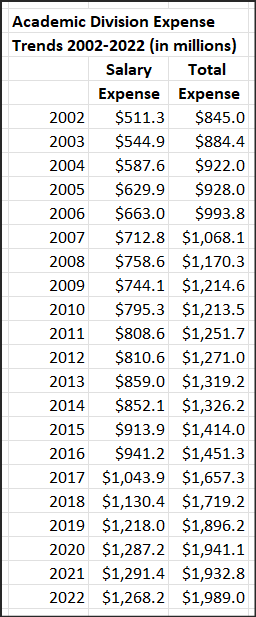
by James A. Bacon
Tis the season for Virginia’s universities to announce how much they are raising tuition & fees for the upcoming academic year. Virginia Tech’s Board of Visitors has jacked up tuition by 4.9% and the College of William & Mary by 4.5%. Virginia Commonwealth University is considering an increase of 4% to 5%, George Mason University 3%. After a bout of inflation that peaked around 9% and is still running about 6%, putting both university and family budgets under stress, the pressure on governing boards is intense.
At the University of Virginia a tuition increase has been baked into the cake since November 2021 when the Board of Visitors approved a two-year increase of 4.7% in 2022-23 and 3.7% in 2023-24. Under pressure from Governor Glenn Youngkin to hold down charges, UVa issued a rebate to in-state undergraduate students to offset last year’s increase. But there has been no indication that the Board will reconsider a refund in 2023-24. In-state undergrads could well find themselves paying 8.4% more next year.
UVa officials, like their peers at the state’s other public universities, blame the failure of state support for higher education to keep pace with growing enrollment and the escalating Consumer Price Index. In the past, UVa’s board has rarely questioned that claim. But now some board members want to dig deeper into the numbers.
Former Rector James Murray, who was appointed by former Governor Ralph Northam, and Bert Ellis, a Youngkin appointee, have publicly expressed concerns about the university’s cost structure. Ellis has suggested that “administrative bloat” — a surge in the number of non-teaching administrators — has added millions of dollars in wasteful costs. Cutting administrative overhead by half to $634 million in 2022, he says, would allow the university to slash tuition, accounting for $669 million in revenue in 2022, to almost zero.
The Ryan administration has not responded to Ellis’ request for a detailed breakdown of payroll costs. But a Jefferson Council analysis of figures taken from 20 years of annual reports shows that salary costs for UVa’s academic division (excluding the UVA Health System) way exceeded the rate of inflation plus the increase in enrollment over the 20 years between fiscal 2002 and fiscal 2022. Indeed, salaries increased (148%) faster than total expenses (135%), suggesting that payroll expansion has been the primary driver in UVa’s cost structure.
To put those numbers in perspective, consider that the Consumer Price Index increased 59% over the same twenty years while enrollment increased 20%. If salaries had risen at the same rate as CPI + enrollment, they would have increased 79%. In other words, after adjusting for inflation and enrollment, expenditures increased about 56% and payroll about 69%.
While it is incontestable that the cost of salaries has increased, the top-level numbers do not answer important questions. Was the increase due mostly to the hiring of faculty, the hiring of administrators, or a mix of both? How much of the increase was due to an increase in pay levels? UVa adopted a $15-per-hour living wage that undoubtedly boosted pay for employees at the lower end of the pay scale. At the same time, older, higher-paid faculty members have been retiring in large numbers and have been replaced by junior faculty who, presumably, are paid less.
The Jefferson Council suspects that the steady increase in payroll cost was driven by the hiring of new staff in response to the university’s mission creep. Among the likely categories:
- To implement its “Inclusive Excellence” program, the university has hired scores of Diversity, Equity & Inclusion staff. By the count of the Virginia Association of Scholars, the university employed 77 DEI administrators in 2021. Equity czar Kevin McDonald says the figure is 40. While the definition of who should be classified as a “DEI” employee is a matter of debate, it is clear that DEI has been a growth area for UVa employment.
- As part of President Jim Ryan’s goal to be both “great and good,” UVa has committed to helping address “social justice” and environmental issues in the Charlottesville area and Virginia. Similarly, the new Karsh Institute for Democracy is dedicated to upholding democracy (primarily from perceived right-wing threats). No count of how many employees are involved in community engagement has been made publicly available.
- UVa has invested in expanding its R&D portfolio, requiring growth in the number of staff devoted to writing and administering research grants. No count of how many employees are involved in research has been made publicly available.
- Responding to the surge in mental illness among students in the past several years, UVa has increased resources for counseling and mental-health treatment. No count of how many employees are involved in student services has been made publicly available.
It is important to note that most of the increase in salary and expense occurred before Jim Ryan became president in 2018. Indeed, both salaries and total expenditures leveled off in 2021 and 2022 as the university came under increasing pressure to hold a lid on tuition hikes.
However, the Jefferson Council is disappointed that the administration has shown little interest in exploring the factors driving expenditures skyward. The cost savings over the past two or three years, we fear, reflect temporary belt-tightening measures, not a restructuring of costs. We worry that inflationary pressures will push tuition dramatically after 2023-24.
The Council has been assured that the University’s new financial information system can spit out large quantities of data at the push of a button. Either the administration doesn’t know the answers, which would be a shameful failure of management, or it doesn’t want to share the answers, which would be a shameful failure of governance. One way or the other, the Jefferson Council is determined to get to the truth.





I was at a recent accepted student event & was stunned to learn the annual tuition is almost $80,000. I paid $20,000 in the 1990s.
Alums are targeted with ultra-aggressive fundraising requests. Somewhere around 2005 a fellow classmate said “it’s like the Univ is never happy with the facilities, always building new buildings.” In the time since the Univ built Nau, Gibson, new new Dorms, incorporated Brandon Ave, (what I have heard President Ryan call) the “Data, Discovery, Democracy” complex, and announced the new Darden conference center & the new Alderman. The McIntire School of Commerce built a new building around 2010 and is now saying it has identified the need (and location) for yet another building.
I wonder if the Univ fundraises to build new buildings or builds buildings to fundraise. Thank you for being “on top of this.” We need to know where does all this money goes.
Have never donated to UVa and no one as ever asked me for a donation. I am assuming they do not need my money.
The truth is that the university as we know it today will not be in existence in 20 years. The expense of the “college experience” is untenable and unaffordable by most people today. This is exactly why internships are flourishing in ALL professions not just for plumbers et al. Internet universities will be the norm. Cheaper no comments or dorm fees. Universities are simply pricing themselves out of existence and UVa is among them.
I would very much lie to know the ratio of administrators to teaching staff.